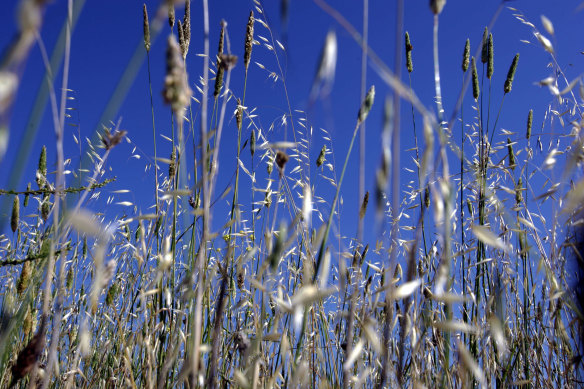This was published 2 years ago
Bad air day: Hayfever, asthma sufferers warned as deluge dries
By Stuart Layt
Recent heavy rain followed by sudden heat will inflame a record pollen season in south-east Queensland, experts warn.
The deluge in the eastern states was set to ease in Queensland into warm weather, with tops in the high 20s and even low 30s later in the week.

Southeast Queensland is already seeing a record pollen season, and experts warn the recent rain will only make matters worse for hayfever and asthma sufferers.Credit: Fairfax Media
QUT Professor Janet Davies, an expert in pollen allergies, said there had been a 4.5-fold increase in the level of pollen in the air in Brisbane in 2022 compared with the previous five-year average.
That built on the 2021 figure, which was itself three times the previous five-year average pollen level.
“Due to the current La Niña weather system we’re seeing much wetter conditions for this time of year in a similar way to last year, and so we’re expecting the pollen season will do something similar to last year,” said Davies, head of the AusPollen research group.
She said rain encouraged new grass growth, especially of types that tended to shed pollen which caused trouble for asthmatics and those with allergies.
“It’s a bit of a mixed bag because some grasses get completely flooded out by rain, and then others crowd in and you get this huge explosion of grasses following large rain events,” she said.
“Given that we are having a particularly wet season now, we would say that will drive an overall increase in the pollen load.”
In addition to causing irritation for those allergic to it, large amounts of pollen in the air can combine with atmospheric conditions to cause a dangerous condition known as thunderstorm asthma.
National Asthma Council Australia director and respiratory physician Professor Peter Wark said the condition was caused by pollen particles getting broken up in the air due to the rough weather, meaning they penetrated much deeper into the lungs than they otherwise would.
If that happened, even people who did not suffer from asthma could find themselves affected.
“A La Niña event now underway in the Pacific Ocean will increase the likelihood of above-average rainfall during spring and summer in eastern Australia, which can lead to above average grass growth and critically, more ryegrass pollen in the air,” he said.
“If you are allergic to ryegrass pollen, you could have a severe asthma attack if you are outside in gusty winds just before or during a thunderstorm in spring or early summer.”
Australia is unlike other countries such as the US which actively monitor pollen levels in many parts of the country.
Davies said while she and her colleagues were part of a network of researchers who monitored pollen levels, there was little top-down consolidation of their data.
They also have to work with mostly broad-scale data, with not much real-time monitoring, however she hoped a new piece of equipment being installed at AusPollen’s Rocklea monitoring station would help change that.
The machine, a SwisensPoleno Jupiter, is the first high-precision automated pollen monitor installed in the southern hemisphere.
“We’re installing that at the end of this week, weather permitting,” Davies said.
“We did a trial of a similar device for six months at the start of the year, and we have high hopes for this one, it has holographic image technology, which will give us higher precision and allow us to look at smaller particles.”